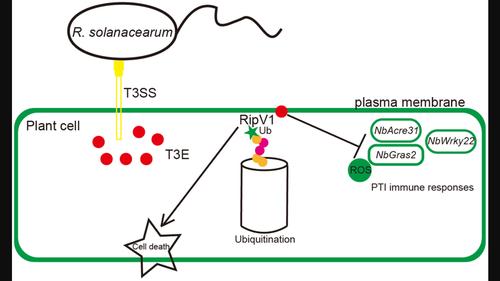Ralstonia solanacearum效应子RipV1作为一种新型E3泛素连接酶抑制植物PAMP触发的免疫反应并促进马铃薯的易感性
IF 2.4
3区 农林科学
Q1 AGRONOMY
引用次数: 0
摘要
由 Ralstonia solanacearum 引起的细菌枯萎病是一种破坏性植物病害,尤其是马铃薯(Solanum tuberosum)。R. solanacearum 部署了多种有效的 III 型效应物来抑制植物免疫系统。然而,人们对促进寄主植物易感性和干扰植物免疫反应的单个效应因子的了解仍然有限。在这里,我们证明了 III 型效应物 RipV1 作为一种新型 E3 泛素连接酶(NEL)效应物,在体外表现出 E3 泛素连接酶活性。RipV1 的瞬时表达抑制了烟曲霉中植物病原体相关分子模式(PAMP)触发的免疫(PTI)反应,如 PTI 相关基因的表达和活性氧(ROS)猝灭。RipV1 的长期表达会诱导 N. benthamiana 叶子中的细胞死亡。值得注意的是,突变 RipV1 的保守半胱氨酸残基会削弱其 E3 连接酶活性及其抑制植物 PTI 反应的能力。这项研究还揭示了 R. solanacearum 在马铃薯中的全面毒力离不开 RipV1。过表达 ripV1 而非催化突变体 ripV1-C444A 的转基因马铃薯植株对 R. solanacearum 的易感性增强。据观察,RipV1 能特异性地定位在植物质膜上,其 N 端是决定这种定位的关键。这些研究结果表明,RipV1 是一种 NEL 效应子,通过其 E3 活性抑制植物 PTI 反应,从而增强了茄枯菌的毒力。本文章由计算机程序翻译,如有差异,请以英文原文为准。

The Ralstonia solanacearum effector RipV1 acts as a novel E3 ubiquitin ligase to suppress plant PAMP‐triggered immunity responses and promote susceptibility in potato
Bacterial wilt caused by Ralstonia solanacearum is a destructive plant disease, particularly in potato (Solanum tuberosum ). R . solanacearum deploys a diverse and potent arsenal of type III effectors to inhibit the plant immune system. However, the understanding of individual effectors promoting susceptibility in host plants and interfering with plant immunity responses is still limited. Here, we demonstrated that the type III effector RipV1 functioned as a novel E3 ubiquitin ligase (NEL) effector and exhibited E3 ubiquitin ligase activity in vitro. Transient expression of RipV1 suppressed plant pathogen‐associated molecular pattern (PAMP)‐triggered immunity (PTI) responses in Nicotiana benthamiana , such as the expression of PTI‐related genes and the reactive oxygen species (ROS) burst. Prolonged expression of RipV1 induced cell death in N . benthamiana leaves. Notably, mutating the conserved cysteine residue of RipV1 abolished its E3 ligase activity and its ability to suppress plant PTI responses. This study also revealed the indispensability of RipV1 for R . solanacearum 's full virulence in potato. Transgenic potato plants overexpressing ripV1 but not the catalytic mutant ripV1‐C444A displayed enhanced susceptibility to R . solanacearum . RipV1 was observed to localize specifically to the plant plasma membrane, with its N‐terminus being pivotal in determining this localization. These findings showcase that RipV1 acts as a NEL effector and contributes to R . solanacearum virulence by suppressing plant PTI responses through its E3 activity.
求助全文
通过发布文献求助,成功后即可免费获取论文全文。
去求助
来源期刊

Plant Pathology
生物-农艺学
CiteScore
5.60
自引率
7.40%
发文量
147
审稿时长
3 months
期刊介绍:
This international journal, owned and edited by the British Society for Plant Pathology, covers all aspects of plant pathology and reaches subscribers in 80 countries. Top quality original research papers and critical reviews from around the world cover: diseases of temperate and tropical plants caused by fungi, bacteria, viruses, phytoplasmas and nematodes; physiological, biochemical, molecular, ecological, genetic and economic aspects of plant pathology; disease epidemiology and modelling; disease appraisal and crop loss assessment; and plant disease control and disease-related crop management.
 求助内容:
求助内容: 应助结果提醒方式:
应助结果提醒方式:


